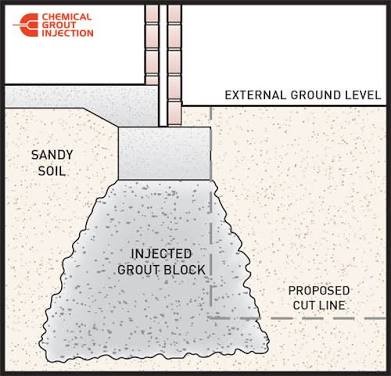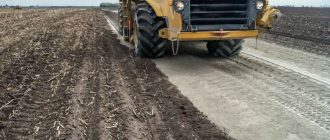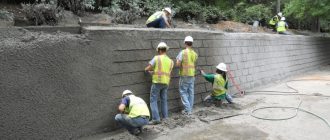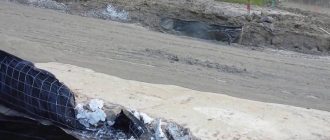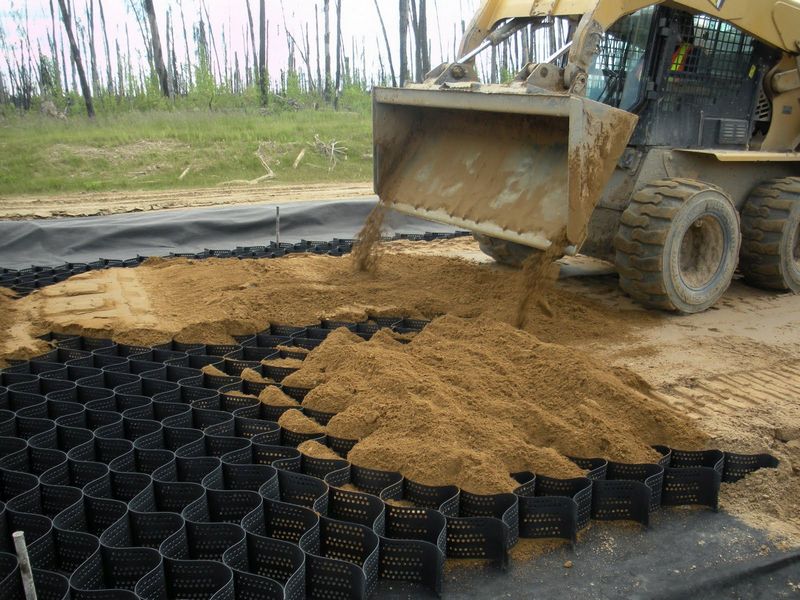
Exploring Modern Stabilization Techniques to Combat Soil Liquefaction.
Soil liquefaction is a phenomenon that can have devastating effects on infrastructure and buildings. It occurs when loose or saturated soil loses its strength and behaves like a liquid, usually due to seismic activity or heavy vibrations. As a result, buildings can sink, tilt, or even collapse, leading to loss of life and significant damage.
Addressing soil liquefaction is of utmost importance in areas prone to earthquakes or ground vibrations. Traditional methods of stabilization, such as compaction and soil replacement, have been used for many years. However, modern techniques have emerged to provide more effective and efficient solutions.
One such technique is soil densification, which involves injecting liquefied soil with cement or other stabilizing agents to increase its density and strength. This process improves the load-bearing capacity of the soil and reduces the risk of liquefaction. Another method is the use of ground improvement techniques, such as deep soil mixing or vibro-compaction, to strengthen the soil and prevent liquefaction.
“Modern stabilization techniques offer promising solutions for addressing soil liquefaction and mitigating its potential risks. These techniques provide a more cost-effective and environmentally friendly alternative to traditional methods, while also improving the overall stability and resilience of the soil.”
Furthermore, advanced monitoring systems and predictive modeling tools have been developed to assess the risk of soil liquefaction and guide the implementation of stabilization techniques. These tools allow engineers to analyze soil properties, seismic activity, and other relevant factors to determine the most suitable stabilization method for a given area.
In conclusion, addressing soil liquefaction is crucial for ensuring the safety and longevity of infrastructure in earthquake-prone areas. Modern stabilization techniques, such as soil densification and ground improvement, offer more effective and efficient solutions compared to traditional methods. By utilizing advanced monitoring systems and predictive modeling tools, engineers can better assess the risk and implement appropriate stabilization techniques, ultimately increasing the resilience of the soil and minimizing the impact of liquefaction.
Addressing Soil Liquefaction: Modern Stabilization Techniques
Liquefaction of soil is a phenomenon that occurs during seismic activity, where the soil loses its strength and behaves like a liquid. This can lead to significant damage to structures, infrastructure, and even loss of life. To mitigate the risks associated with soil liquefaction, modern stabilization techniques have been developed.
These techniques aim to improve the engineering properties of soil and reduce the potential for liquefaction. One commonly used technique is soil compaction, where the soil is compacted to increase its density and improve stability. This can be done using heavy machinery, such as rollers or vibrating plates, to apply pressure to the soil.
Another technique is the use of ground improvement methods, such as soil mixing or deep soil mixing. These methods involve the mechanical mixing of soil with cement or other stabilizing agents to increase its strength and reduce liquefaction potential. This process can be performed using specialized equipment, such as augers or excavation machinery.
In addition to mechanical stabilization techniques, there are also chemical stabilization methods available. These involve the injection of chemicals or grouts into the soil to alter its properties and increase stability. This can include the use of lime, cement, or other chemical agents that react with the soil to form a more stable matrix.
Furthermore, modern techniques for addressing soil liquefaction include the installation of ground improvement systems, such as geosynthetics or ground anchors. These systems provide additional reinforcement and stabilization to the soil, preventing liquefaction and improving overall stability.
It is important to note that the selection of the appropriate technique depends on various factors, including site conditions, soil properties, and the desired level of improvement. An engineering analysis should be conducted to assess the suitability and effectiveness of each technique.
In conclusion, addressing soil liquefaction requires the implementation of modern stabilization techniques. These techniques aim to improve soil strength, reduce liquefaction potential, and enhance overall stability. By utilizing these techniques, the risks associated with soil liquefaction can be minimized, ensuring the safety and integrity of structures and infrastructure in seismic-prone areas.
Understanding Soil Liquefaction
Soil liquefaction is a phenomenon that occurs when saturated soils lose their strength and behave like liquid under stress. This can result in the sinking, tilting, or even collapse of structures built on the affected soil. Liquefaction is a significant concern in areas prone to earthquakes or seismic activity.
The modern understanding of soil liquefaction has led to the development of various stabilization techniques aimed at addressing this issue. These techniques involve strengthening the soil to prevent or minimize the effects of liquefaction.
One of the commonly used techniques for addressing soil liquefaction is dynamic compaction. This technique involves using heavy machinery to apply repeated impacts or vibrations to the ground, increasing the soil density and reducing its susceptibility to liquefaction.
Another method involves installing lime columns within the soil. Lime is mixed with the soil through deep soil mixing or by injecting it directly into the ground. The lime reacts with the soil, increasing its strength and reducing the potential for liquefaction.
Other stabilization techniques include the use of geosynthetics, such as geotextiles or geomembranes, which provide additional reinforcement to the soil. These materials can improve the soil’s stability and prevent the occurrence of liquefaction.
Understanding soil liquefaction and the modern stabilization techniques available is crucial for engineers and construction professionals working in areas prone to this geological hazard. By implementing appropriate measures, the risk of structural damage and the associated financial and human costs can be significantly reduced.
Causes of Soil Liquefaction
Soil liquefaction is a phenomenon where saturated soil loses its strength and stiffness due to a sudden increase in pore water pressure. This can occur during earthquakes, intense vibrations, or other dynamic loading conditions. Understanding the causes of soil liquefaction is crucial in implementing effective stabilization techniques to address this issue in a modern context.
One primary cause of soil liquefaction is the presence of loose, cohesionless soils such as sand and silty sands. These types of soils have a high water content and lack cohesive forces between particles, making them more susceptible to liquefaction.
Another contributing factor is the presence of a high groundwater table. When the groundwater table rises close to the ground surface, it increases the pore water pressure within the soil, reducing its strength and causing liquefaction.
Dynamic loading from earthquakes or intense vibrations is also a significant cause of soil liquefaction. The shaking motion exerted on the soil generates high pore water pressure, which can exceed the soil’s ability to dissipate the excess water and maintain its stability.
Furthermore, the age and stress history of the soil play a role in its susceptibility to liquefaction. Younger, less consolidated soils are generally more prone to liquefaction due to the lack of interparticle bonding, while previously liquefied soils can remain in a liquefied state more easily in subsequent loading events.
Having a thorough understanding of the causes of soil liquefaction allows engineers to apply modern stabilization techniques that can mitigate the effects of liquefaction and enhance soil stability in susceptible areas. These stabilization techniques can include ground improvement methods, such as compaction grouting, deep soil mixing, or installation of stone columns, which increase the soil’s resistance to liquefaction and improve its overall stability.
The Role of Water Content in Soil Liquefaction
Water content plays a crucial role in the occurrence of soil liquefaction, a phenomenon where saturated soils lose their strength and behave like a liquid under the influence of stress. Understanding the relationship between water content and soil liquefaction is essential in developing effective techniques for addressing this issue.
When the water content in soil increases, the soil particles become surrounded by water molecules, creating a lubricated environment. This lubrication reduces the friction and cohesion between soil particles, making the soil more susceptible to liquefaction when subjected to stress. Higher water content increases the pore water pressure, which counteracts the effective stress within the soil matrix.
Modern stabilization techniques aim to mitigate soil liquefaction by reducing the water content in the soil and improving its overall stability. One commonly used technique is electro-osmosis, which involves applying a direct electrical current to the soil to remove excess water. This process uses the principle of electromigration, where the movement of water is induced by an applied electric field. Other techniques include soil compaction, grouting, and the use of geotextiles to control water movement.
By addressing the water content in soil, these modern stabilization techniques can enhance its strength and prevent soil liquefaction. They help to increase the effective stress within the soil, reducing the potential for liquefaction during seismic events or other stress-inducing activities.
It is important to note that different soils have varying susceptibilities to liquefaction based on their compositions and pore structures. Therefore, site-specific evaluations are necessary to determine the optimal stabilization technique and water content for addressing soil liquefaction in a particular location.
Assessing Soil Liquefaction Potential
Before addressing soil liquefaction through modern stabilization techniques, it is crucial to assess the potential for liquefaction to occur in a particular area. This assessment helps determine the most appropriate stabilization methods and ensures their effectiveness.
The assessment of soil liquefaction potential involves evaluating various factors, including but not limited to:
| Liquefaction Susceptibility | Examining the soil’s susceptibility to liquefaction based on its composition, density, and groundwater content. |
| Shear Strength | Measuring the soil’s shear strength, which is crucial in determining its resistance to liquefaction under dynamic loading. |
| Groundwater Level | Assessing the groundwater level in the area and its potential influence on the soil’s liquefaction susceptibility. |
| Seismicity | Considering the seismicity of the area, including the intensity and frequency of earthquakes, as they can trigger soil liquefaction. |
Various methods are used to assess soil liquefaction potential, such as laboratory testing, field investigations, and geotechnical analysis. These methods provide valuable data and insights that guide engineers in designing appropriate stabilization techniques to address soil liquefaction.
Overall, assessing soil liquefaction potential is a critical step in the process of stabilizing soil and preventing potential damage to structures and infrastructure. By accurately evaluating the factors mentioned above, engineers can develop effective strategies to mitigate the risks associated with soil liquefaction.
Traditional Methods of Soil Stabilization
Liquefaction is a phenomenon that occurs when saturated soil loses its strength and behaves like a liquid during an earthquake or other seismic activity. This can lead to significant damage to infrastructure and pose risks to human life. Addressing the issue of soil liquefaction is crucial to ensuring the stability of buildings and structures.
In the past, traditional methods of soil stabilization have been used to mitigate the risks associated with liquefaction. These techniques involve modifying the soil properties to improve its strength and stability.
One such technique is compaction, which involves increasing the density of the soil by applying mechanical energy. This process reduces the voids within the soil and increases its shear strength. Compaction is commonly used for stabilizing loose, granular soils.
Another traditional method is soil mixing, which involves blending additives into the soil to improve its properties. This can include the addition of cement, lime, or other stabilizing agents. The additives strengthen the soil and enhance its ability to resist liquefaction.
Yet another technique is soil replacement, where unstable soil is removed and replaced with more stable material. This can involve excavating the liquefiable soil and replacing it with compacted sand or gravel.
All of these traditional methods have been employed successfully in the past, but they may have limitations and downsides. They can be time-consuming, expensive, and may not always provide a long-term solution. However, with the advancements in modern stabilization techniques, new methods are being developed that offer more efficient and effective solutions to the problem of soil liquefaction.
In the next section, we will explore some of these modern techniques that are revolutionizing the field of soil stabilization and offering innovative solutions to mitigating soil liquefaction.
Modern Soil Stabilization Techniques
Soil liquefaction is a phenomenon that occurs when saturated soil loses its strength and stiffness, resulting in a transformation from a solid state to a liquid state. This can have catastrophic consequences for structures built on such soil, as they can sink or tilt, leading to structural failure and damage.
Fortunately, modern soil stabilization techniques have been developed to address this issue and mitigate the risks associated with soil liquefaction. These techniques aim to improve the strength and stability of the soil, preventing or minimizing the potential for liquefaction.
One commonly used technique is soil compaction. By compacting the soil, the void spaces are reduced, increasing the density and strength of the soil. This can be achieved through mechanical means, such as using vibrating rollers or compactors, or through the application of pressure and vibration.
Another technique is the use of chemical stabilizers. These stabilizers, such as lime or cement, are mixed with the soil to chemically react and bind the particles together. This process, known as soil cementation, increases the strength and cohesion of the soil, making it less susceptible to liquefaction.
Furthermore, soil reinforcement techniques can also be employed to stabilize liquefaction-prone soil. This involves the use of geosynthetic materials, such as geotextiles or geogrids, which are embedded in the soil to provide tensile strength and improve stability. These materials act as a reinforcement, distributing the load and preventing the soil from undergoing liquefaction.
In addition to these techniques, advanced analytical methods, such as site investigation and geotechnical modeling, are utilized to assess the soil conditions and design appropriate stabilization measures. This allows engineers and geologists to identify potential liquefaction hazards and determine the most effective and efficient solutions.
Overall, modern soil stabilization techniques offer effective solutions for addressing soil liquefaction and reducing the associated risks. By employing a combination of compaction, chemical stabilization, soil reinforcement, and advanced analysis techniques, engineers can ensure the stability and safety of structures built on liquefaction-prone soil.
Deep Soil Mixing for Stabilization
Liquefaction is a common issue faced in areas with loose or sandy soil, especially during earthquakes or other seismic activities. Addressing this problem requires effective soil stabilization techniques that can prevent ground movement and potential damage to structures. One modern method that has proven successful in addressing soil liquefaction is deep soil mixing.
Deep soil mixing involves the injection of cementitious materials or other stabilizers into the ground to improve its strength and stability. This technique is particularly effective in areas with loose or weak soil conditions, as it creates a stronger composite material that can withstand liquefaction and reduce the risk of ground failure.
- During the deep soil mixing process, a special mixing rig is used to inject the stabilizing material into the ground.
- The rig is equipped with rotating mixing blades that mix the stabilizer with the soil, ensuring an even distribution of the added material.
- The depth of the soil mixing can vary depending on the specific project requirements, typically ranging from a few meters to tens of meters.
After the mixing process is complete, the injected material reacts with the soil to form a solidified mass that improves the overall stability and strength of the ground. The result is a significantly reduced risk of liquefaction during seismic events.
Deep soil mixing has gained popularity as a modern technique for addressing soil liquefaction due to its effectiveness, cost-efficiency, and minimal environmental impact. It allows for stabilization of the ground without the need for extensive excavation or the placement of additional structural elements.
Overall, deep soil mixing offers a reliable and sustainable solution for addressing soil liquefaction, making it a valuable tool in the field of modern soil stabilization.
Compaction Grouting as a Stabilization Method
One of the modern techniques used to address soil liquefaction and provide stabilization is compaction grouting. This method involves injecting a stable, high-strength grout into the soil to compact it and increase its density, therefore improving its load-bearing capacity.
Compaction grouting is typically used in areas where soil liquefaction poses a significant risk, such as earthquake-prone regions. The process involves drilling holes into the unstable soil and then injecting the grout in a controlled manner. As the grout is injected, it fills the voids and displaces the water in the soil, effectively compacting it and reducing its potential for liquefaction.
This stabilization method can be highly effective in improving the overall strength and stability of the soil. It not only increases the density of the soil, but also creates a stronger bond between soil particles. This helps to prevent the formation of water-filled voids and reduces the risk of liquefaction during seismic events.
Compaction grouting can be used in both loose and dense soils, making it a versatile option for stabilization. It can be applied in various geotechnical scenarios, including underpinning foundations, stabilizing slopes, and reinforcing retaining walls.
However, it is important to note that compaction grouting is a complex process that requires careful planning and execution. Site-specific conditions and factors such as soil composition and water content must be considered to ensure optimal results. Additionally, continuous monitoring and testing are essential to determine the effectiveness of the grouting and ensure the desired stabilization objectives are achieved.
In conclusion, compaction grouting is a modern technique that can effectively address soil liquefaction and provide stabilization. By compacting the soil and increasing its density, this method improves its load-bearing capacity and reduces the risk of liquefaction during seismic events. However, proper planning, execution, and monitoring are crucial to ensure successful outcomes.
Chemical Stabilization Methods
In addition to the modern stabilization techniques addressing soil liquefaction, chemical stabilization methods have also been developed to improve the stability of soils. These methods involve the use of chemicals to alter the properties of the soil and enhance its engineering characteristics.
Chemical binders are commonly used in chemical stabilization methods. These binders, such as cement, lime, or fly ash, are mixed into the soil to increase its strength and reduce its susceptibility to liquefaction. They react with the soil particles and form a cementitious matrix, effectively bonding the particles together and providing additional rigidity.
Polymer additives are another type of chemical used in soil stabilization. These additives, such as polyacrylamide or polyurethane, are mixed with the soil to improve its cohesion and reduce its permeability. They help the soil particles to bind together, forming a stronger and more stable soil structure.
Chemical stabilization methods can be particularly useful in areas with high liquefaction potential, as they can significantly improve the soil’s resistance to liquefaction and mitigate the associated risks. They are often used in combination with other stabilizing techniques, such as densification or vertical drains, to achieve the desired level of stability.
Ground Improvement Techniques to Prevent Liquefaction
Addressing the issue of soil liquefaction requires the implementation of modern stabilization techniques. These techniques aim to strengthen the soil and reduce its susceptibility to liquefaction during seismic events.
One commonly used technique is deep soil compaction, also known as dynamic compaction. This involves the use of heavy machinery to apply repeated impacts or vibrations to the ground, which consolidates loose soil particles and increases the density of the soil. By doing so, the soil becomes less prone to liquefaction due to its increased stability.
Another effective stabilization technique is the installation of stone columns, also known as vibro stone columns. This technique involves the insertion of large stone columns into the ground, which are then compacted using vibrations. These columns serve as reinforcement for the soil and improve its load-bearing capacity, reducing the potential for liquefaction.
Jet grouting is another technique used to prevent liquefaction. This process involves injecting a high-pressure grout mixture directly into the ground, which forms compacted columns or panels. The grout mixture solidifies and reinforces the soil, increasing its resistance to liquefaction.
Additionally, the use of ground improvement materials, such as geotextiles and geogrids, can provide stabilization against liquefaction. These materials are often used in combination with other techniques to enhance the strength and stability of the soil. Geotextiles and geogrids act as reinforcement layers, distributing the loads more evenly and reducing the potential for liquefaction.
Overall, modern ground improvement techniques offer effective solutions for addressing soil liquefaction. By implementing these techniques, the stability and strength of the soil can be increased, reducing the risk of liquefaction and its potentially damaging effects during seismic events.
Frequently asked questions:
What is soil liquefaction?
Soil liquefaction is a phenomenon in which saturated soil loses its strength and stiffness and behaves like a liquid during an earthquake or other seismic event.
What causes soil liquefaction?
Soil liquefaction is caused by the increase in pore water pressure due to shaking during an earthquake, which reduces the effective stress in the soil particles and causes them to lose their strength.
How can soil liquefaction be addressed?
Soil liquefaction can be addressed through various modern stabilization techniques, such as compaction grouting, dynamic compaction, deep soil mixing, and ground improvement through the use of stone columns or geosynthetic materials.
What is compaction grouting?
Compaction grouting is a technique in which a low-slump grout is injected into the ground to compact and densify the soil, effectively improving its stability and resistance to liquefaction.
How effective are modern stabilization techniques in addressing soil liquefaction?
Modern stabilization techniques have proven to be highly effective in addressing soil liquefaction. They can significantly improve the stability and resistance of soil to liquefaction, reducing the potential damage and risks associated with earthquakes.

